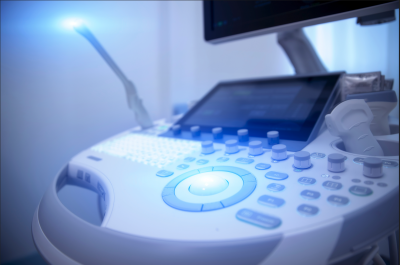
Written by

Cranfield, UK, 14/12/23 – The medical imaging market is set for a period of innovation and evolution with disruptive forces shaping a new future for imaging modalities. Changes within local manufacturing and outpatient imaging are set to change market dynamics. Emerging markets will be important regions to invest in for vendors to secure substantial global market shares. Provider adoption of edge AI technology and increasing pressures on pricing will see vendors re-evaluate strategies and research and development priorities, to meet customer needs and differentiate in an increasingly commoditised market.
Increased Pricing Pressures
Global challenges with supply chain and increased manufacturing costs lead to reactionary pricing measures by vendors aimed at mitigating impact on profits, resulting in imaging system prices increasing 5-10% in 2022 and 2023. Despite this, market demand remained, propped up by government COVID funding. Vendor supply chain overhaul from 2021-2023 will also optimise costs for the near term, leading to predicted flat/negative pricing trend from 2025.
Pricing pressures will remain with Chinese vendors making aggressive moves into the international market as their domestic market cools. Less affected by supply chain issues and backed by governmental support these vendors have become more active within the medical imaging market. With COVID funding depleting across Europe in 2023-2024, Chinese vendors are situated to take advantage of restricted budgets, starting in the less mature Eastern regions and some Southern European markets. Then, once established, broadening their scope to the Western areas, where the market is harder to penetrate , and providers have a more premium demand.
In local for local disrupts the dynamic
Government desire for self-sufficiency, post the pandemic fallout and with current global economic issues, has spurred many emerging markets to adopt local manufacturing policies. Though most are not set to make waves, some are worth keeping a close eye on.
The ‘Make in China 2025’ policy outlining the governments’ preference for locally manufactured systems, coupled with the rise of Chinese vendors has depleted the market opportunity for international OEMs to compete within one of the largest imaging markets. A key growth and manufacturing hub, Chinese vendor dominance of their domestic market and manufacturing will make it harder for global vendors to remain present and active in the surrounding second and third tier markets. Decreased pricing makes these vendors more favourable in emerging areas where healthcare budgets are lower.
Unlike the Chinese strategy of pushing out international investment, ‘Make in India’ and its production linked incentive (PLI) is positioned to drive international vendor investment into the country. Increasing domestic manufacturing efforts aids in improved local access to higher quality imaging healthcare at a lower price point. The policy has the potential to be leveraged by international vendors to resolidify their presence in the emerging APAC regions and capitalise on the growing market in India.
GE Healthcare has made early moves to take advantage of in “local for local” policies to gain market share through a new deal with Kazakhstan as part of a larger government project. More than $60 billion was invested by the government across four areas including localizing medical equipment production. They plan to produce ultrasound, CT, angiography and mammography systems in the country and will invest in programmes to increase the development of the Kazakh healthcare system. The move strengthens GE’s presence in the Middle East and Western Asia, providing significant land-based transportation routes around the region and gets Kazakhstan closer to their goal of 50% domestic production of medical equipment and pharmaceuticals by 2025.
Outpatient Imaging
The shift toward outpatient imaging in mature markets has been emerging more prevalently since the pandemic, due to a focus on patient convenience, decentralising services from acute hospital sites, changes in reimbursement and the need for better access to imaging. Recent Centres for Medicare & Medicaid Services cuts in radiology reimbursement and strengthened rules on surprise billing has accelerated the movement of the USA market split towards outpatient imaging over hospital-based imaging, with an outlook to soon reach 60:40 respectively. Outpatient centres have an increasing need for high-efficiency lower priced systems, with a primary aim of increasing turn-around times and imaging capacity. With the change in-channel and location, imaging vendors must re-market themselves to cater to this increasingly influential market sector.
The drive for efficiency in outpatient imaging often focuses on adapting and improving current imaging systems and workflow rather than the implementation of new technology. Providers are therefore leaning towards vendors offering additional “bolt-on” operational AI solutions that are easily integrated and consolidate current workflows, as opposed to substantial new capital outlays. Moreover, with budgeting restrictions and sustainability concerns growing, there is more focus on reducing unnecessary system replacements.
The outpatient market is also very diffuse in the US, the largest global imaging market; while an increasing number of hospital acquisitions of outpatient centres is starting to see outpatient centres connected into larger health systems, the need for standardisation and consolidation of imaging systems and workflows remain a challenge. Operational AI solutions that standardise the provider imaging workflow regardless of system OEMs are looking to solve this, along with improved scheduling and resource planning.
Investing in Edge AI
The demand for AI expands outside outpatient imaging, with healthcare providers globally seeking solutions to help their staff keep up with growing imaging demand.
Edge-based AI for medical imaging sits within the imaging device, housing the data locally on the modality system, unlike other AI solutions where the data sits outside of the device e.g., on the cloud. This offers a multitude of benefits that can be applied to AI applications, most popular in image reconstruction, acquisition, and image analysis. The key benefit for radiology departments being that edge AI mitigates the latency experienced when data is transmitted to the cloud, enabling local analysis of the scan which can deliver real-time feedback to the clinician.
Real-time analysis enables providers to make faster clinical care decisions by highlighting key components in the scan to reduce reading time, increasing patient turn around and decreasing treatment times. This functionality has the potential to play a key role in the future of ED care where treatment decisions are time sensitive, and the treating clinician isn’t always an expert in the clinical area of the injuries.
Edge-based AI has low availability in the current market offerings. With providers driving demand, as the ROI is proven, it is likely that we will see vendors increasing their built in AI system offerings as a key market differentiator.
As has been noted, the above factors have a weighty bearing on the market. However, there remains plenty of opportunity in the imaging space with changing trends opening up mature markets. But, if its market share vendors are looking to secure, they will need to shift gear and start seeing the value in emerging market investment as the regions grow to become increasingly influential.
Related Research
Signify Research’s report ‘The Medical Imaging Yearbook 2023’ is designed to support industrial supply chain and upstream component vendors, software vendors, healthcare providers, big technology and financial service clients better understand the critical aspects of the medical imaging ecosystem in total, leveraging information from the detailed suite of deep-dive medical imaging market reports and services offered by Signify Research.
About Aiyana Amess
Aiyana joined Signify Research in 2023 as part of the Medical Imaging team. She graduated from Loughborough University with a BSC in Medicinal and Pharmaceutical Chemistry, receiving a diploma in industrial studies after completing an internship at Roche.
About Signify Research
Signify Research provides healthtech market intelligence powered by data that you can trust. We blend insights collected from in-depth interviews with technology vendors and healthcare professionals with sales data reported to us by leading vendors to provide a complete and balanced view of the market trends. Our coverage areas are Medical Imaging, Clinical Care, Digital Health, Diagnostic and Lifesciences and Healthcare IT.
Clients worldwide rely on direct access to our expert Analysts for their opinions on the latest market trends and developments. Our market analysis reports and subscriptions provide data-driven insights which business leaders use to guide strategic decisions. We also offer custom research services for clients who need information that can’t be obtained from our off-the-shelf research products or who require market intelligence tailored to their specific needs.
More Information
To find out more:
E: enquiries@signifyresearch.net
T: +44 (0) 1234 986111
www.signifyresearch.net
